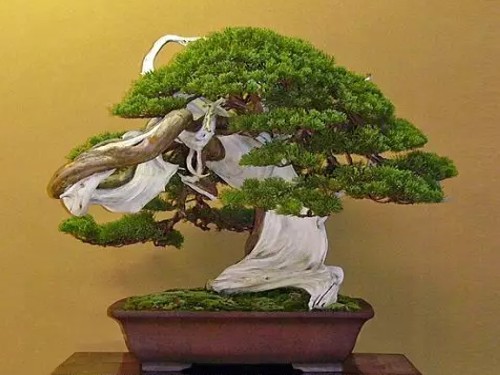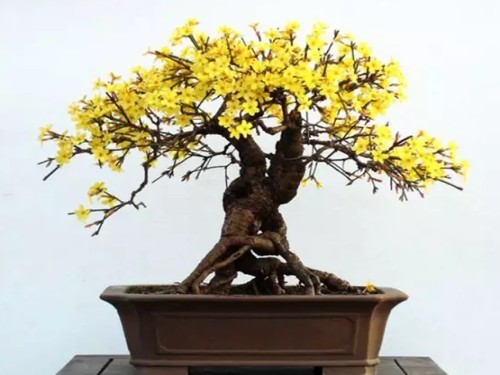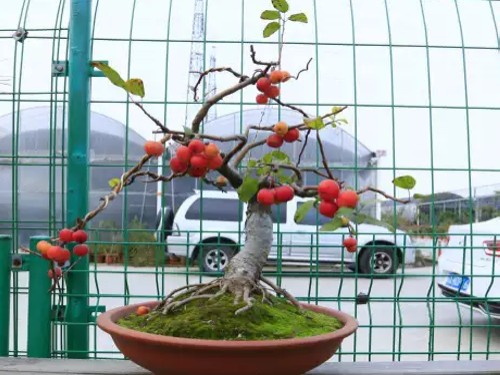Techniques for making pine and cypress bonsai
Shandong is one of the birthplaces of ancient Chinese culture. On Mount Tai, the head of the five mountains, there are various kinds of ancient pines on Mount Tai and Houshiwu; in the Zhongjun account Temple in Culai Mountain, there are ancient pines that are hundreds of years old; in the loan Temple in Tai'an, some people call it "Gubai Linghan". In Lingyan Temple and Qufu Konglin, there are many old Qiu branches that have experienced Cangsang ancient cypress. In these places, the welcome pine is like a cover, the sister pine is towering, the withered top pine is old, and there is a multi-dry edge theory, the "flag pine" against the wind, while the pine forest on the top of the cliff is lush and majestic and upright.
Cypress shape due to the difference between leaves and pine, so the level should not be too clear. The wood of cypress is resistant to decay, and it can create withered branches, withered shapes, withered branches can be peeled, and withered branches can be shaped and peeled after shaping. Cypress bonsai often use Platycladus orientalis trees, but the branches and leaves of Platycladus orientalis are rough and messy, and the general shape is monotonous, which gives people a sense of chaos after shaping, which affects the ornamental value, which is its disadvantage. Platycladus orientalis branches are old and changeable, and big branches are easy to shape, which is the strength of Platycladus orientalis. In the creation of Platycladus orientalis bonsai, if we can give full play to our strengths and avoid weaknesses and return to simplicity, we should adopt the natural form of ancient cypress in Qufu and Lingyan Temple as blue wood, highlighting the aging of the trunk. In the cultivation of main branches, the use of scattered modeling, so that the proportion of dry branches coordinated, Qiu qu changeable, reduce the number of messy twigs and leaves, can overcome the disadvantages of rough leaves and improve the appreciation value of Platycladus orientalis.

In the modeling of pine and cypress bonsai, according to the characteristics of the above-mentioned cultural landscape and combined with the sturdy and dwarfing characteristics of Shandong mountain pines and cypresses, the old trunk and thick branches and vegetables were cut to lower the trunk and reduce the crown, and then the method of rough pruning and tidying was adopted to guide the tree crown according to the situation. so that the crown is intertwined with its natural shape and levels. There are small changes between each large level, which not only has a sense of integrity, but also is not disorderly, has the beauty of natural formation, and makes full use of dwarfing wild pile resources. the black pine stump is used to change the crown into five-needle pine by grafting, high branch grafting and bud grafting. The use of rich Platycladus orientalis stump resources to replace the crown into cypress, cypress and other cypress bonsai, forming a unique bonsai style of Shandong pine and cypress.
The mountain field pile digging should select the surface root is stout, the distribution is uniform, the tree trunk has a certain degree of curvature and change, and the branch thickness, especially the main branch thickness and trunk thickness should be coordinated. Dig wild piles, do not scatter roots and transplant, it is best to use the original mountain soil when planting. Plant a good post-ventilated sunny place, spray leaf water frequently, and water again when the surface of the basin soil is not dry. Do not apply fertilizer to the new pile of the pine tree in that year.
On the basis of the original techniques, we also absorb the strengths of other places, use the wire binding and shaping method, select the corresponding thickness of the wire according to the thickness of the branches, and twist and hang the branches in the inappropriate angle position to meet the needs of plastic surgery. Before plastic surgery to repeatedly review its tree potential, depending on the straight stem, the position of the main branch and take advantage of the situation, to be determined first, can be reshaped from bottom to top. The vertical planes between the layers should not overlap too much, in order to facilitate the growth and light transmission, otherwise the Tian Chang Di Jiu (Eternal Dumpling), the shaded part will naturally die out of control.
The pines and cypresses in the Mingcha Temple in the natural mountains are generally past their prime of life, that is, they stop growing to high places. The lateral growth of the branches increases, the branches grow densely and extend length, the branches droop due to weight and rain and snow, and the branchlets on the branches grow horizontally. Therefore, in plastic surgery, standing branches and branches should be kept at a horizontal or drooping angle, the size of the angle depends on their needs, and the branches can be bent horizontally. If the top branches can droop, they will look older. Due to modeling reasons, the coexistence of lower branches and rising branches can not be ruled out, but it should be in accordance with the law of growth in the natural environment.
The length of the upper and lower branches is generally long and short. From the front of the appreciation, the front branches are short and the back branches are long, and the trunk and main branches should be exposed. The proportion of the lowest main branches of the trunk should be coordinated.
The trunk and thick branches which are not easy to be bent by wire and hanging method can be bent by finger-to-finger insertion method which has been tested for many years. If it is a large thick branch, you can use a knife to deep above the part that needs to be bent to half the depth of the diameter, and the length depends on the need. Cut several strips in this way, and cut horizontally on the head separated by one strip, and vice versa at the other end. If you bend it hard, the horizontal broken head will tilt up, as if the two hands are oblique to each other. After the main branch or trunk is fixed, the warped part can be embedded in the slot and entangled with adhesive tape, so that it can heal well after 2023.
Cypress is native to China and is a temperate tree species. Like light, but have a certain degree of shade tolerance. Like warm, humid climate, but also adapt to dry and cold and warm and humid conditions. Resistant to cold, it can grow at-25 degrees, and the leaves turn brown in cold conditions. The soil is not strict and can grow under acidic, neutral and alkaline conditions. It has strong salt resistance and can grow in soil with a salt content of 0.2%. Resistant to drought and barren, it can also grow in rock crevices. But it also has a certain degree of moisture resistance. The root system is well developed, there are many fibrous roots, and it is resistant to transplantation. Long life, slow growth, Mount Tai, Qufu and other places have more than 2000 cypress trees. The propagation of cypress is mainly by sowing method. Seed preservation period of about 2 years, generally harvested in November, sun-dried storage, in order to be exposed to moisture. Soak the seeds in spring and sprout after 2 weeks. The first leaves of the cypress are needle-like leaves, followed by scaly leaves, and all are scaly leaves after 2 years. Generally speaking, the growth rate is faster in the young and young stages, moderate and slow in adulthood, and slower in the old trees.
How to make cypress bonsai? The production of cypress bonsai is divided into the following steps:
1. Material selection: the source of cypress bonsai materials is the sowing method, which is cultivated and modeled from the seedlings. As the seedling is resistant to transplantation and easy to shape, it can be processed and shaped gradually according to the design requirements. Although it takes a long time, the bonsai is ideal. Another way is to dig from the wild. In nature, there are some old cypress stumps that have been beaten by wind and rain for years. Lightning strikes and animal or man-made damage, forming a variety of strange shapes, some broken, some hollow, some hanging roots, some withered, these are ideal materials for making bonsai. The root system of cypress is well developed, especially the fibrous root is rich. When digging, we can first cut off its main root and retain the fibrous root. The aboveground part should be cut short, and the cluttered branches and leaves clustered on the branches should be cut off, as well as the long branches of the culms, and the branches should be arranged in parallel, and pay attention to keeping the withered branches. As cypress grows slowly, it is necessary to retain as many branches as possible. The appropriate time for digging is after early winter and before germination in early spring. When transplanting, you should bring soil balls to protect the roots. When you are unable to bring a soil ball, you should try your best to ensure the integrity of the fibrous root, and adopt water spraying and shading measures, and put it on the basin as soon as possible to reduce the time of leaving the soil. Bare root transplantation can be carried out in the rainy season.
2, judging the tree set: the cypress is not afraid of the cold, the snow is frozen, and it is still green as usual, so it has the praise of evergreen pine and cypress. The production of cypress bonsai highlights its vigorous, straight and majestic features. Some cypress skin has been peeled, or hollow, but still luxuriant branches and leaves, heroic posture, such cypress can be made into dry type. Some tree trunks are naturally inclined, and the bark is mottled with rich antiquity, which can be made into oblique dry type, and single or double trunk can be determined according to the condition of the branches. Some ancient cypresses grow in cliffs, mountain streams or stone crevices, and the trunk bends sharply from the root neck, like a waterfall, majestic, which can be made into a cliff style. Some cypress pile branches bend left and right, potential if you long, strange shape, natural, can make horizontal dry type or flat dry type. Some roots are exposed or suspended, and the old roots are vertical and horizontal, which can be used to make exposed-root bonsai. In short, according to the natural form of cypress pile, follow its situation, seize its charm, and highlight its spirit.
3. Pruning and stereotyping: cypress trees generally do not make heavy pruning because of their slow growth, but mostly adopt the methods of cultivation, combined with pruning and adjustment, so that they have a natural demeanor, but are not stiff and stiff. The ancient pile of cypress tree has the characteristics of rotation and distortion, natural rhythm and unique grace. Therefore, the whirling method is not used in the shape of cypress pile, which makes the trunk form a spiral longitudinal crack, showing an elegant arc curve. The branches and roots of some stumps are withered and eroded, which can be guided according to the situation, shaped with the class, and properly carved artificially to achieve the effect of letting nature take its course and being better than nature. The newly dug stump, the branches are relatively long and too dense, retain the drooping branches and the lower branches of the crown, restrain the strong branches, make the structure of the trunk and side branches compact and distribute naturally, and can be processed according to the natural growth law by using the traditional binding and pulling techniques.
Time: 2019-05-26 Click:
- Prev

Steps of making bonsai of primrose
Primrose has small and supple branches, well-developed root system, strong sprouting power, pruning resistance, golden green calyx, gorgeous and funny, so it is a good bonsai material. Primrose bonsai branches flat bend, green vines facing the wind, golden flowers according to the eyes, full of ancient interest. It is a good taste for ornamental flowers in cold winter and early spring. And the branches of primrose are sprouting and resistant to pruning.
- Next

The method of making bonsai with winter red fruit
Winter red fruit, also known as longevity fruit, is a deciduous shrub or small tree of the genus Rosaceae, with grayish brown branches, alternate leaves, oval to widely elliptic leaves, green, with round and obtuse serrated edges. Corymbose inflorescences with pale pink flowers blooming from March to April. The fruit is oval, green at first, and then yellow gradually.
Related
- Fuxing push coffee new agricultural production and marketing class: lack of small-scale processing plants
- Jujube rice field leisure farm deep ploughing Yilan for five years to create a space for organic food and play
- Nongyu Farm-A trial of organic papaya for brave women with advanced technology
- Four points for attention in the prevention and control of diseases and insect pests of edible fungi
- How to add nutrient solution to Edible Fungi
- Is there any good way to control edible fungus mites?
- Open Inoculation Technology of Edible Fungi
- Is there any clever way to use fertilizer for edible fungus in winter?
- What agents are used to kill the pathogens of edible fungi in the mushroom shed?
- Rapid drying of Edible Fungi

